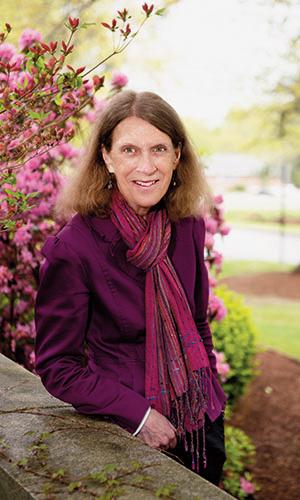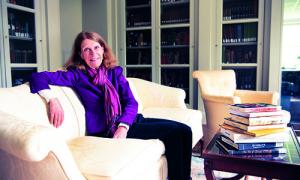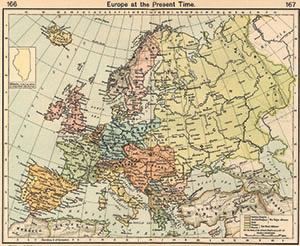
Photos by Kevin Harkins
During my time teaching as a full-time professor in the fine arts department at Saint Anselm College, I have been grateful to receive three Fulbright awards to spend time teaching and doing research in various European countries.
J. William Fulbright was a prominent American 20th-century statesman, who served more than 30 years in the United States Congress as both a member of the House of Representatives and of the Senate from Arkansas. He was also president of the University of Arkansas from 1939-1941, at the time the youngest university president in the country. In 1946, his legislation in the Senate established the Fulbright Program. The first U.S. participants in the program went overseas in 1948, and the program continues to have significance, fostering the importance of cultural diplomacy and advancing mutual understanding at various international levels.
The Fulbright Experience
In 2006, I was awarded a Fulbright Distinguished Chair position at the Karl Franzens University in Graz, Austria. During the spring semester of 2006, I taught several courses in American art history and studies, to both graduate and undergraduate students. I greatly enjoyed living and working in Graz, and having the opportunity to visit other Austrian cities, including Vienna and Salzburg.
Following my semester in Graz, I continued to be in touch with the chair of the American studies department and we co-sponsored, and participated in, a number of sessions at various European Association for American Studies conferences throughout Europe. In 2014, I was awarded a Fulbright Specialist award to teach in the American studies department during the summer session at Ruhr University in Bochum, Germany. I have continued to be in touch with one of the professors there, and was happy to be able to host her at Saint Anselm College when she and her mother came to visit. She was particularly impressed with our Chapel Art Center, and greatly enjoyed meeting Father Iain MacClellan, O.S.B., director of the Chapel Art Center, who graciously served them tea in his office area.
During the fall semester 2017, I was grateful to receive an early sabbatical leave from the college, in order to accept a Fulbright Terra Foundation award to teach in the American studies department at Radboud University in the city of Nijmegen, in the Netherlands. My responsibilities included teaching a course, “History of American Photography, 1900-1970,” specifically prepared for carrying out this award. Students in the class were from a variety of backgrounds and cultures, including the Netherlands, Spain, and Afghanistan. I was very pleased to receive a round of applause at the end of the course, which apparently does not happen often, and a number of students came up to me individually to thank me at the end of the course. I also gave a guest presentation and assisted with a graduate, master’s-level course, “Mediating America,” taught by the chair of the department. I also worked individually with a master’s degree student and a Ph.D. student, related to their research interests.
Besides teaching in the American studies department, I attended and contributed to regular departmental weekly or biweekly meetings. As with my other Fulbright awards, I also gave guest lectures. At Radboud, one of my lectures was titled “Documents, Art Work, and/or Critical Propaganda: Alfred Stieglitz’s ‘291’ Installation Photographs.” Two of the seven books I have written have been on the work of the photographer Alfred Stieglitz.
In addition to working in the American studies department at Radboud, I also met individually on several occasions with faculty in the art history and cultural studies departments. I gave a guest presentation in the art history department: “Fighting for the Light: Selected Female Photographers in the Alfred Stieglitz Circle.”
Part of the Fulbright Terra award also involved working on a research project that I had proposed, dealing with the work of Stieglitz during the time he was working in the Netherlands: “Exploring Transnational Modernist Connections: Alfred Stieglitz and Painting/Photography in the Netherlands.”
I was able to use the Radboud University library for research, related to this project and other aspects of my work. I also visited the small coastal town of Katwyk, where Stieglitz took a number of photographs. I spent time at the museum there as well.
A Saint Anselm Connection Abroad
I visited a number of other museums in the Netherlands, in Nijmegen, Amsterdam, The Hague, Rotterdam, Utrecht, Maastricht, ‘s-Hertogenbosch, and Delft that included some Dutch paintings that had influenced Stieglitz.

In Delft, I was able to meet Diego Nicolas, the son of Sylvia Nicolas HD ’91. Sylvia Nicolas sculpted the bronze statues of Saint Anselm and of Saint Benedict on campus, among other works, and she and her family created the stained glass windows in the Saint Anselm Abbey Church. Diego showed me the stained glass windows created by his family in the Delft “Old Church.” I was able to purchase a book about those windows to share with members of the Saint Anselm College community.
Living in the city of Nijmegen, considered by many to be the oldest city in the Netherlands, also allowed me to explore various aspects of Dutch history, in particular, the impact of World War II and the well-known September 1944 Operation Market Garden on the city and the area, including the neighboring town of Arnhem, which I visited on several occasions. That event served as inspiration for the book and film A Bridge Too Far.
During a brief study break, I traveled to Paris, where the Terra Foundation European office and library are located. I was able to meet with people at the foundation, discussing both my research and teaching, as well as use the library there. The Terra Foundation is particularly interested in supporting the study and exhibition of American art in European and other foreign venues. I was also able to visit a number of Paris art museums, including the Pompidou Center and the Cinema Museum.
Living the Fulbright Mission

As with my two previous Fulbright awards, I plan to continue to be in touch with a number of faculty with whom I worked in the Netherlands. During all of my Fulbright awards, I greatly enjoyed hearing a variety of perspectives related to international relations, both past and present, and felt it was most valuable to work at various international locations as well as meet with a variety of people.
In the U.S., I have also become actively involved in the New Hampshire Fulbright Association and have attended Fulbright conferences in Washington, D.C., and other locations. I greatly believe in the power of cultural diplomacy to foster important aspects of international and mutual understanding. The mission of the Fulbright program continues to be of much importance in our contemporary world.
Word Works
Published books by Professor Emerita Katherine Hoffman
An Enduring Spirit: The Art of Georgia O’Keeffe (Scarecrow Press, 1984)
Collage: Critical Views (UMI Research Press, 1989)
Explorations: The Visual Arts Since 1945 (Harper Collins, 1991)
Concepts of Identity: Historical and Contemporary Images of Self and Family (Harper Collins, 1997)
Georgia O’Keeffe: A Celebration of Music and Dance (George Braziller Books, 1998)
Stieglitz: A Beginning Light (Yale University Press, 2005)
Alfred Stieglitz: A Legacy of Light (Yale University Press, 2011)
Professor Emerita Katherine Hoffman retired in May 2019 after 29 years of teaching on the Hilltop. She is currently working on her next book, Fighting for the Light: Female Photographic Pioneers in the Alfred Stieglitz Circle and Collection, to be published by Yale University Press. She lives in Peterborough, N.H.
